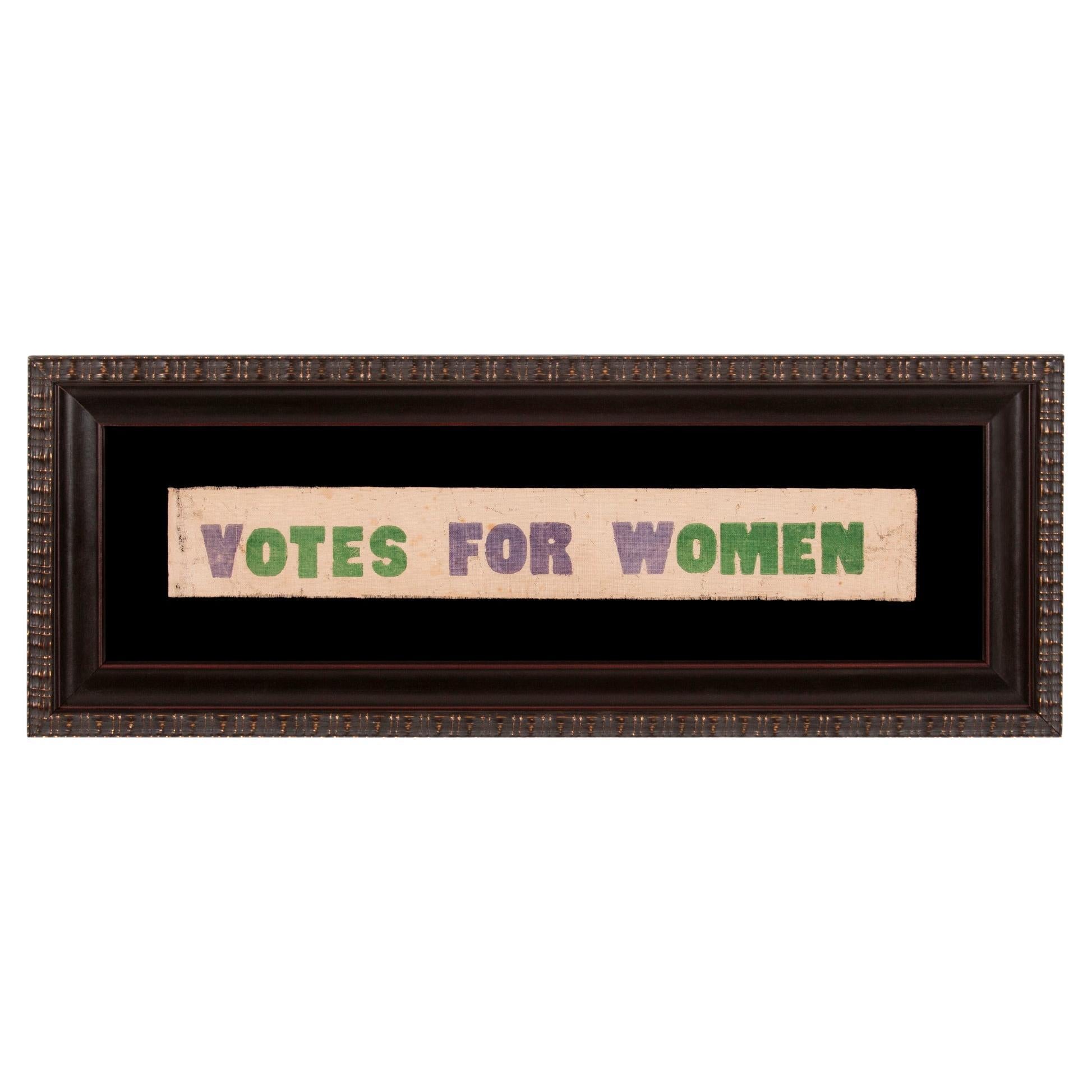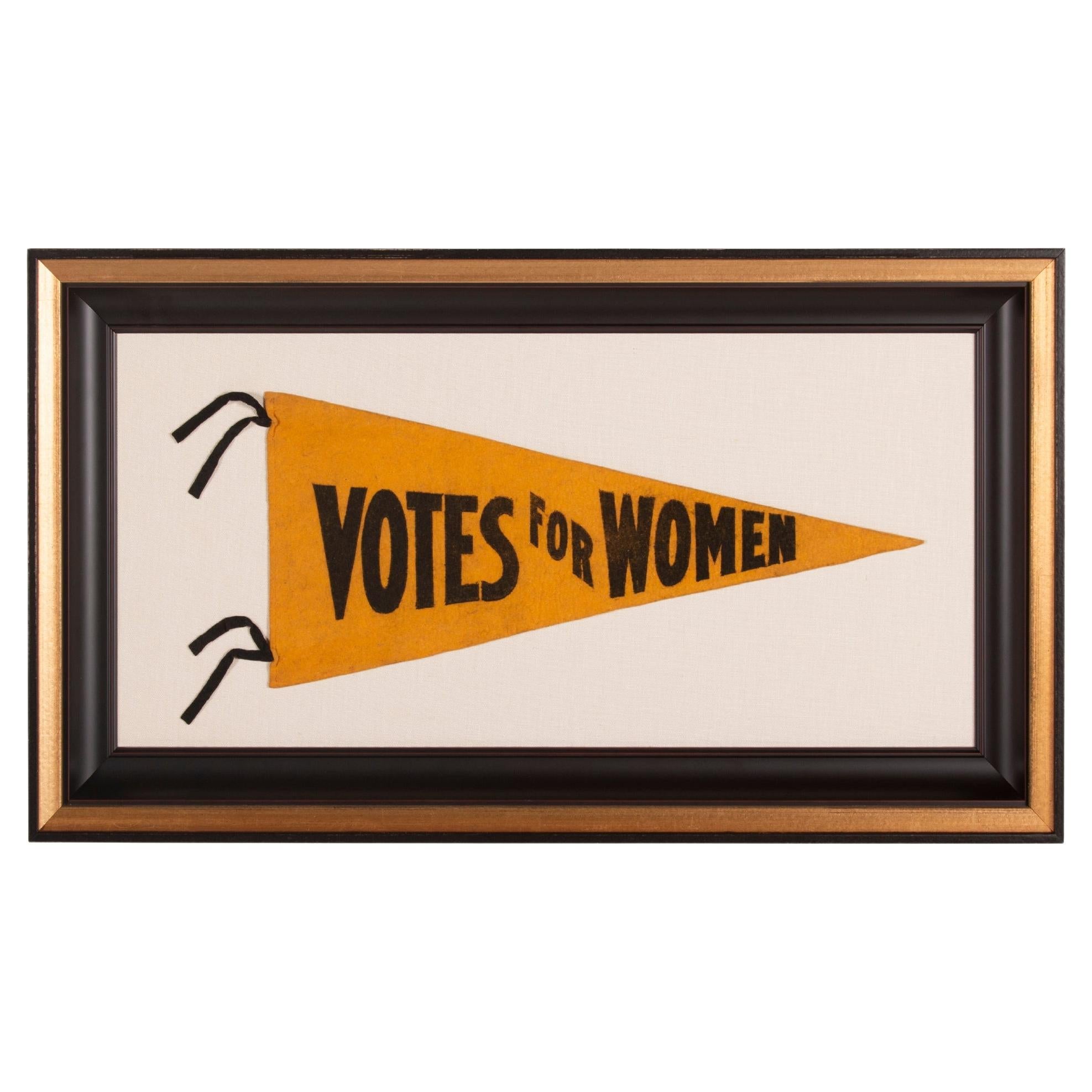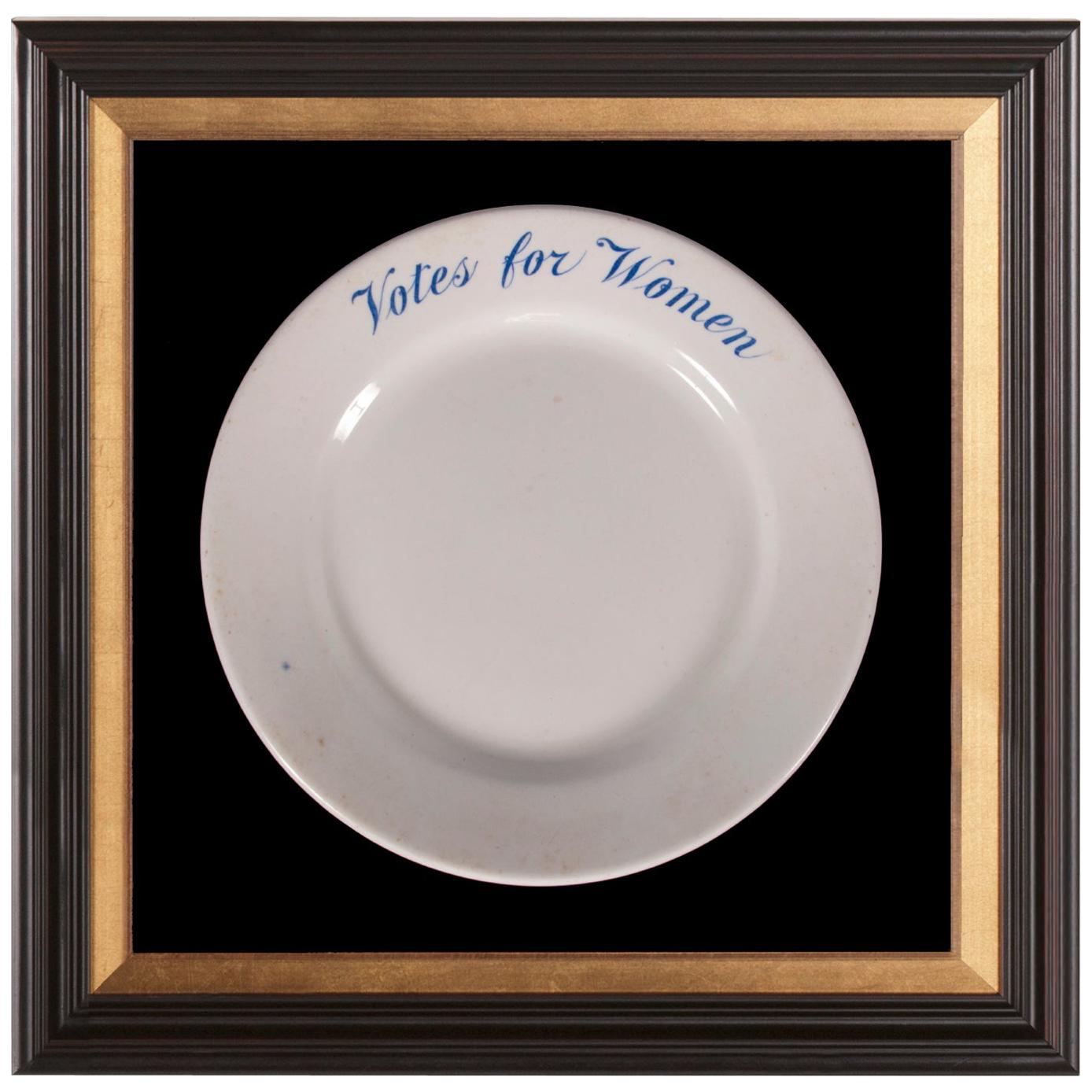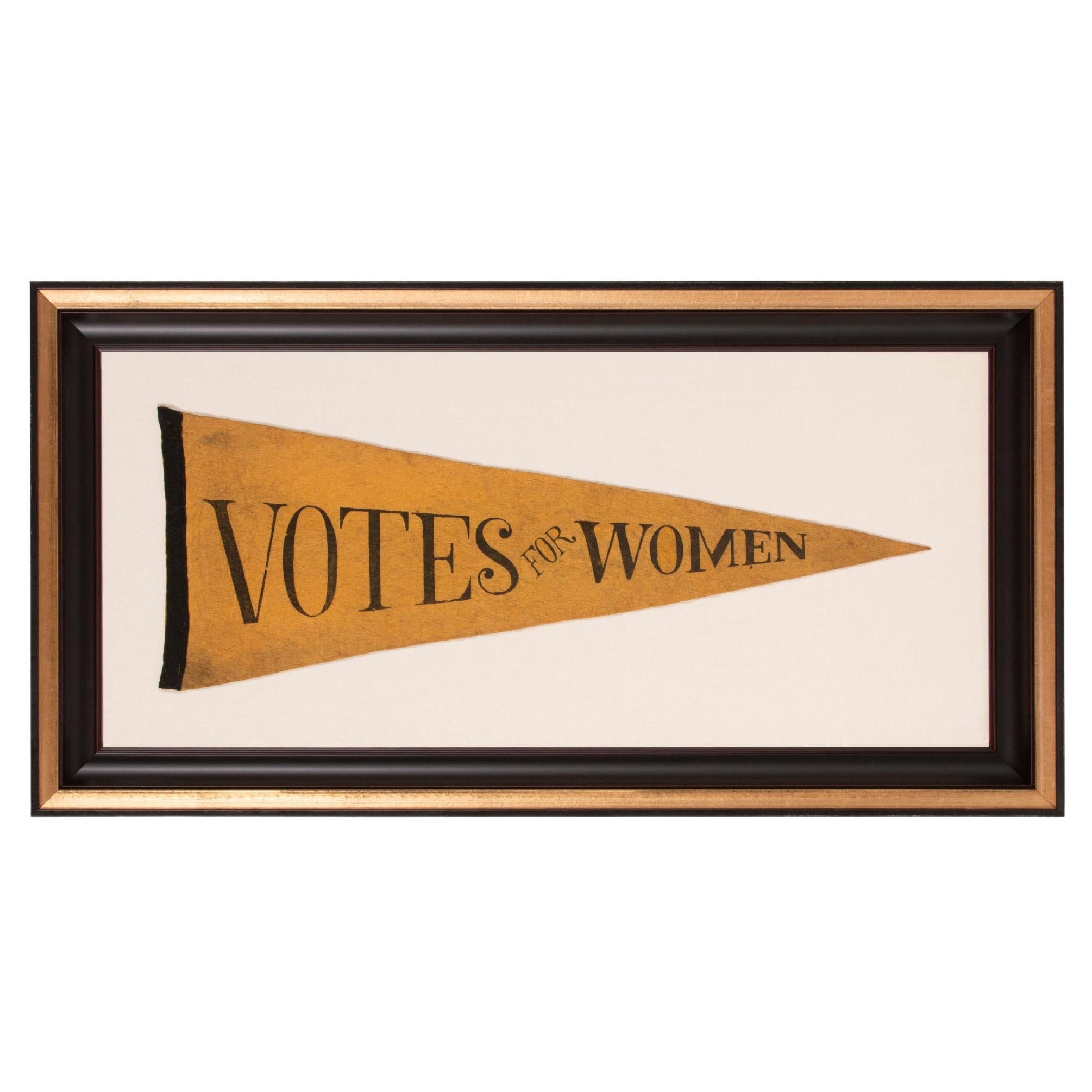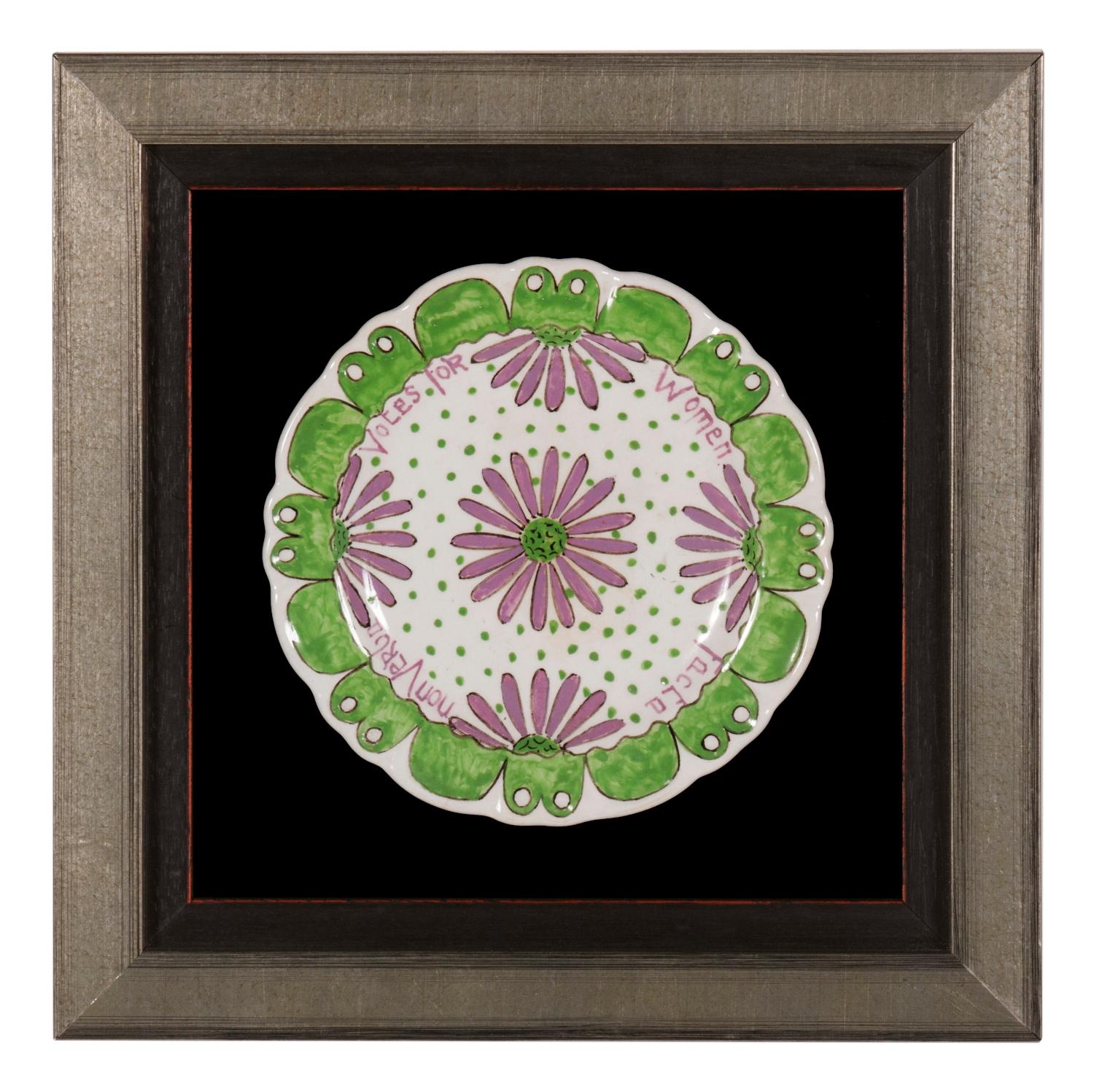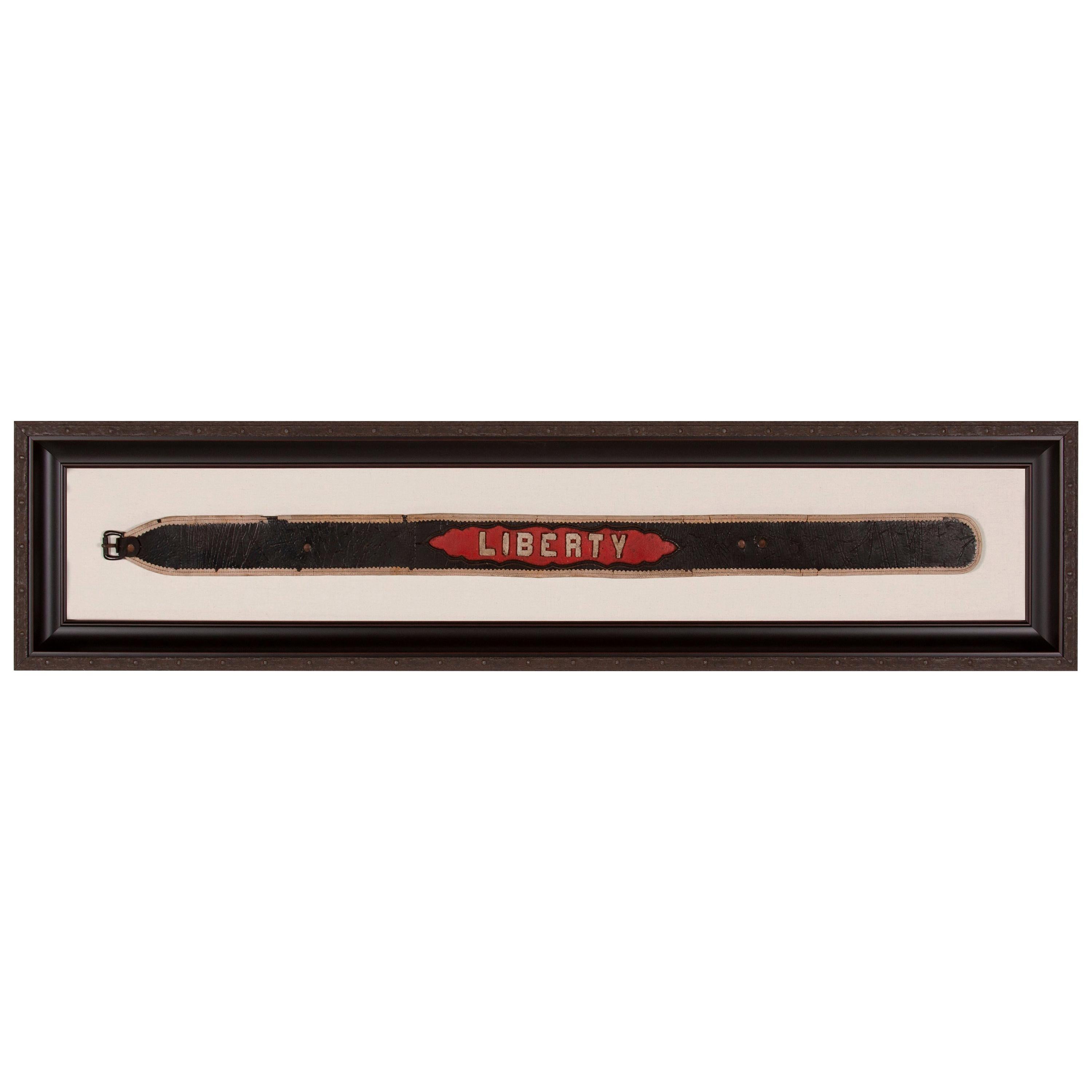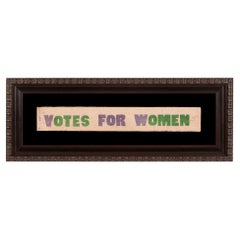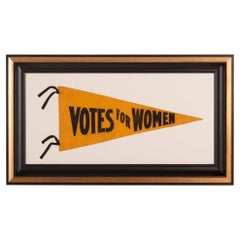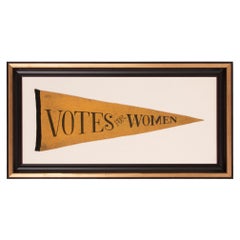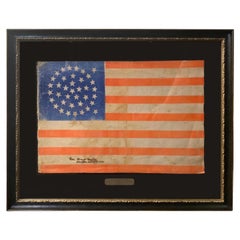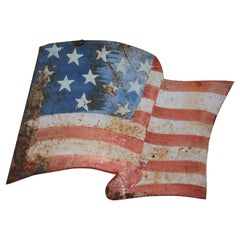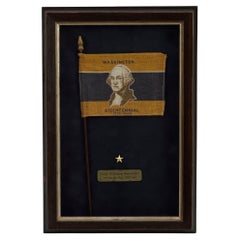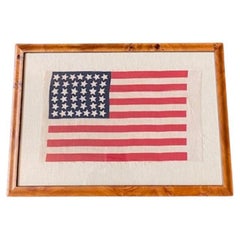Artículos similares a Votes for Women Parade Textile in Purple and Gren
¿Quieres más imágenes o vídeos?
Solicita imágenes o vídeos adicionales al vendedor
1 de 6
Votes for Women Parade Textile in Purple and Gren
Acerca del artículo
VOTES FOR WOMEN PARADE TEXTILE IN PURPLE AND GREEN, OF A TYPE WORN AS SASHES AND WAVED AS NARROW PARADE BANNERS, MADE IN HARTFORD, CONNECTICUT BY CALHOUN PRESS FOR THE WOMEN'S POLITICAL UNION OF NEW YORK, CONNECTICUT, AND NEW JERSEY, ORGANIZED BY CARRIE STANTON'S DAUGHTER, HARRIOT EATON STANTON BLATCH, 1910-1915
American textiles produced to advertise the Suffragette movement are scarce and highly coveted. This small example, printed in purple and green on thin, white-painted canvas, is of a type both flown as banners and worn as sashes. Made in at least three sizes, of which this was likely the smallest, the textile was produced by the Calhoun company of Hartford, Connecticut. This information is known because at least three examples of closely related design and color, in the largest known scale (approx. 14 x 60 inches), were discovered together, with a Calhoun maker’s mark printed in the lower right-hand margin. Also present was the union bug of the Allied Printing Trades Council of Hartford, which denoted that they were printed with union labor. A 14-inch long example, like this one, was discovered with that trio of banners.
This textile is known to have been produced for the Women's Political Union (WPU), the primary chapter of which was headquartered in New York City, with subsidiaries in Connecticut and New Jersey. The WPU was the brainchild of American suffragette leader Harriot Eaton Stanton Blatch (b. 1856, d. 1940). Harriot was the daughter abolitionist Henry B. Stanton and suffrage pioneer Elizabeth Cady Stanton, who served as the first president of the National American Woman Suffrage Association (NAWS) and co-authored the landmark, four-volume, "History of Woman Suffrage" with Susan B. Anthony, Matilda Joslyn Gage, and Ida Husted Harper. Following graduation from Vassar College, Harriot assisted these women by compiling research for the book. She then moved to England for 20 years, marrying a British businessman. In 1902, she returned to the States and became involved with two significant suffrage groups, the Women’s Trade Union League and the National American Woman Suffrage Association. In 1907, disgruntled with their ineffectiveness and stagnation, she founded the Equality League of Self-Supporting Women, which appealed to the working class. Before this time the suffrage organizations in America were largely represented by socialites, whose numbers could not effectively influence the vote. In 1910 the Equality League changed its name to the Women's Political Union (WPU) and organized America's first large-scale suffrage parade, which took place on Fifth Avenue in New York.
To differentiate the activities of the WPU, Harriot adopted the green, white, and violet colors of her British suffragette peers, suggested by some to represent “Give Women the Vote.” Golden Yellow was the most often used color in the States. In 1915, the WPU merged with suffragette leader Alice Paul's Congressional Union, which later morphed into the National Woman’s Party. This banner likely represents the period of Blatch's leadership of the WPU, between 1910 and 1915.
Examples of this textile, in all three sizes, can be seen in a 1915 photograph of Suffragettes advertising an August 26th rally at the casino in Long Branch, New Jersey, where Anna Howard Shaw was the keynote speaker. This event was held in anticipation of the forthcoming New Jersey state election, held on October 19th of that year. At least four of the five women in the image are wearing this exact version, pinned across their chests diagonally, as sashes. It's amazing to see documented record of these textiles in use, in the period.
This same type of textile is also known to have been affixed to narrow, black-painted, curved handle parade canes, made of bamboo, to be waved as narrow parade flags. A crossed pair of these can be seen in the same image, behind the second woman from the right.
Brief History of Calhoun Press:
The Calhoun company, which, like many 19th century businesses, changed its name many times, was a pioneer in large scale printed banners and broadsides. Foremost it was a producer of circus, wild west show, theatrical, and other posters, though its work expanded to many other areas, including newspaper printing. An article published in the Hartford Courant on November 13th, 1908, provides a concise summary of maker's history until that year:
"For more than half a century the name “Calhoun” has appeared on theatrical paper, but the property of the concern, which has so long made Hartford its home, is now for sale, under and order authorizing Timothy Drake, the receiver of the Calhoun Show Print Company to sell. The Calhoun Steam Printing company, which was a pioneer in the line of large-type printing, was formed in 1852 by Alexander and Robert Calhoun, brothers, and Alexander Calhoun is considered the father of the house which was dealt with show people and others all these years. Both of the original Calhoun’s are dean and no member of the Calhoun family has been connected with the business for a number of years, but the name has been an asset and it has always been retained."
By the turn-of-the-century the firm had been renamed Calhoun Printing Company. In 1910 it was sold to Thomas F. Dignam, who re-named it Calhoun Press, Inc. When Thomas passed, in 1934, his son, John V. Dingham took over and ran the company until he passed, in 1979. Although no longer run by a member of the Dingham family, Calhoun Press is still in business today.
Mounting: The textile was mounted and framed within our own conservation department, which is led by expert staff. We take great care in the mounting and preservation of flags and have framed thousands of examples.
It has been hand-stitched to a background of 100% cotton twill, black in color, that has been washed and treated for colorfastness. The mount was placed in a two-part frame that consists of a cove-shaped molding, dark brown in color, nearly black, with reddish undertones and highlights, to which a rippled profile molding, black with gold highlights, was added as a cap. Spacers keep the textile away from the glass, which is U.V. protective.
Condition: There is minor to modest soiling, fading, and pigment loss throughout. There is a small hole in the lower left corner and a partial tear / threadbare area above it, extending into the top edge near the corner. There is a tiny hole above the “W” and there is minor fraying around the edges. The textile presents beautifully and the great scarcity of suffrage textiles well-warrants the condition.
Frame Size (H x L): 7.25" x 19.5"
Flag Size (H x L): 2.5" x 14"
- Dimensiones:Altura: 18,42 cm (7,25 in)Anchura: 49,53 cm (19,5 in)Profundidad: 3,81 cm (1,5 in)
- Materiales y técnicas:
- Lugar de origen:
- Época:
- Fecha de fabricación:1910-1915
- Estado:See Item Description.
- Ubicación del vendedor:York County, PA
- Número de referencia:Vendedor: ws-1411stDibs: LU849745247712
Sobre el vendedor
5,0
Vendedor reconocido
Estos prestigiosos vendedores son líderes del sector y representan el escalón más alto en cuanto a calidad y diseño de artículos.
Establecido en 1991
Vendedor de 1stDibs desde 2008
69 ventas en 1stDibs
Tiempo de respuesta usual: de 1 a 2 días
- EnvíoRecuperando presupuesto…Envío desde: York County, PA
- Política de devolución
Partes de esta página se han traducido automáticamente. 1stDibs no puede garantizar la exactitud de las traducciones. El inglés es el idioma predeterminado de este sitio web.
Garantía de autenticidad
En el improbable caso de que haya algún problema con la autenticidad de un artículo, ponte en contacto con nosotros en un plazo de 1 año para recibir un reembolso total. DetallesGarantía de devolución de dinero
Si tu artículo no es como se describe, sufre daños durante el transporte o no llega, ponte en contacto con nosotros en un plazo de 7 días para recibir un reembolso total. DetallesCancelación dentro de las 24 horas
Tienes un período de gracia de 24 horas para reconsiderar tu compra, sin preguntas.Vendedores profesionales aprobados
Nuestros vendedores de primera clase deben cumplir estrictos estándares de servicio para mantener la integridad de nuestros anuncios.Garantía de igualación de precios
Si encuentras que un vendedor publicó el mismo artículo por un precio menor en otro lado, igualaremos ese precio.Entrega global de confianza
Nuestra red de transporte de primera ofrece opciones de envío especializado en todo el mundo, que incluye envío personalizado.Más de este vendedor
Ver todoTextil del desfile Votes for Woman, fabricado en Hardford, CT, hacia 1910-1915
TEXTIL DEL DESFILE VOTES FOR WOMEN EN MORADO Y VERDE, DEL TIPO DE LOS QUE SE LLEVAN COMO FAJAS Y SE ONDEAN COMO ESTRECHOS ESTANDARTES DE DESFILE, HECHO EN HARTFORD, CONNECTICUT POR C...
Categoría
Vintage, Década de 1910, Estadounidense, Recuerdos políticos y patrióticos
Materiales
Algodón
Banderín del Movimiento por el Sufragio Femenino c/ color en negrita, texto Votes For Women, 1912-1919
Banderín del movimiento Sufragista Americano, con un cono triangular estándar. De fieltro amarillo, con letras cónicas que dicen simplemente: "Voto para las mujeres", impresas en neg...
Categoría
principios del siglo XX, Estadounidense, Recuerdos políticos y patrióticos
Materiales
Fieltro
Placa Sufragista de Ironstone con texto Votes for Women, hecha para Alva Belmont, 1914
PLACA DE IRONSTONE CON TEXTO "VOTES FOR WOMEN" (VOTOS PARA LAS MUJERES), HECHA POR JOHN MADDOCK & SONS PARA LA SUFRAGISTA ALVA BELMONT PARA MARBLE HOUSE, SU FAMOSA FINCA EN NEWPORT, ...
Categoría
Vintage, Década de 1910, Inglés, Recuerdos políticos y patrióticos
Materiales
Porcelana
Banderín "Vota por las mujeres" del Movimiento Sufragista Americano, hacia 1912-1920
BANDERA DEL MOVIMIENTO SUFRAGIO AMERICANO CON TEXTO "VOTOS PARA LAS MUJERES", DE GRAN TAMAÑO Y CON UNA ATRACTIVA PATINA DE ANTIGÜEDAD Y USO OBVIO, hacia 1912-1920
Banderín del movim...
Categoría
principios del siglo XX, Estadounidense, Recuerdos políticos y patrióticos
Materiales
Fieltro
Placa sufragista, "Hechos, no palabras" y "Voto para las mujeres", el único ejemplo conocido
PLATO SUFRAGISTA DE PORCELANA INGLESA CON LOS LEMAS "HECHOS, NO PALABRAS" Y "VOTOS PARA LAS MUJERES", ÚNICO ENTRE LOS EJEMPLARES CONOCIDOS, CA 1905-1918
Plato de porcelana inglesa,...
Categoría
principios del siglo XX, Inglés, Recuerdos políticos y patrióticos
Materiales
Porcelana
Cinturón de cuero para desfile de bomberos
Cinturón de cuero para desfile de bomberos con la palabra "LIBERTY" en blanco sobre fondo rojo, Bloomsburg, Pensilvania, hacia 1900
Este cinturón de bomberos es del tipo que se fa...
Categoría
Antiguo, Principios del 1900, Estadounidense, Recuerdos políticos y patr...
Materiales
Cuero
También te puede gustar
Bandera de 38 estrellas del desfile americano, izada en una recepción al presidente Grant, 1880
Se trata de una bandera de desfile estadounidense de 38 estrellas, bellamente coloreada, que ondeó en una recepción pública para Ulysses S. Grant en octubre de 1880. Esta bandera imp...
Categoría
Antiguo, Década de 1880, Estadounidense, Recuerdos políticos y patrióticos
Materiales
Algodón
Bandera de desfile original de metal pintado
Este divertido y folclórico letrero de bandera de desfile original pintado del siglo XX se utilizaba para colocar en los escaparates durante los actos patrióticos. En tiendas y hogar...
Categoría
Antiguo, Fines del siglo XIX, Estadounidense, Adirondack, Recuerdos polí...
Materiales
Estaño
1036 US$ Precio de venta
Descuento del 20 %
Bandera de desfile "Bicentenario de Washington 1732-1932", impresa en dorado y azul, c. 1932
Se presenta una bandera del desfile del Bicentenario de George Washington de 1932. La bandera está impresa con franjas doradas, blancas y azules, con un destacado retrato de busto de...
Categoría
Vintage, Década de 1930, Estadounidense, Recuerdos políticos y patrióticos
Materiales
Tela, Madera
Bandera de desfile estadounidense de 38 estrellas, hacia 1877
Antigua Bandera de Desfile Americana de 38 Estrellas, circa 1877, una pequeña bandera de desfile de fino lino tejido con 38 estrellas en un atrevido diseño de "Estrella Danzante", pr...
Categoría
Antiguo, Década de 1870, Estadounidense, Federal, Recuerdos políticos y ...
Materiales
Lino
Escultura busto de mujer francesa "Marianne" Diosa de la Libertad en madera maciza, años 60
Escultura francesa vintage de busto de mujer Marianne ha sido la personificación nacional de la República Francesa desde la Revolución Francesa, como personificación de la libertad, ...
Categoría
Vintage, Década de 1960, Francés, Moderno de mediados de siglo, Bustos
Materiales
Madera
1405 US$ Precio de venta
Descuento del 58 %
Abanderada de 13 estrellas para la Celebración del Centenario
Esta pequeña y encantadora bandera de 13 estrellas se fabricó y vendió durante la celebración del Centenario de la nación en Filadelfia en 1876. Se fabricaron todo tipo de banderas p...
Categoría
Antiguo, Década de 1870, Estadounidense, Recuerdos políticos y patrióticos
Materiales
Tela
